英语句子成分和句型结构
讲义:句子成分及句子结构
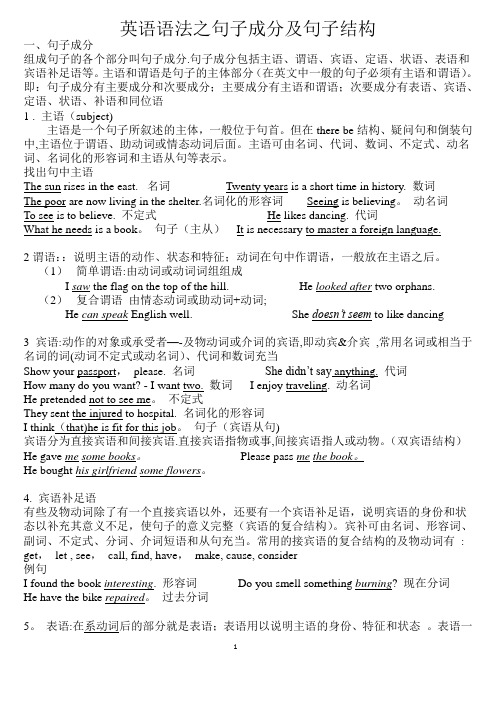
英语语法之句子成分及句子结构一、句子成分组成句子的各个部分叫句子成分.句子成分包括主语、谓语、宾语、定语、状语、表语和宾语补足语等。
主语和谓语是句子的主体部分(在英文中一般的句子必须有主语和谓语)。
即:句子成分有主要成分和次要成分;主要成分有主语和谓语;次要成分有表语、宾语、定语、状语、补语和同位语1 . 主语(subject)主语是一个句子所叙述的主体,一般位于句首。
但在there be结构、疑问句和倒装句中,主语位于谓语、助动词或情态动词后面。
主语可由名词、代词、数词、不定式、动名词、名词化的形容词和主语从句等表示。
找出句中主语The sun rises in the east. 名词Twenty years is a short time in history. 数词The poor are now living in the shelter.名词化的形容词Seeing is believing。
动名词To see is to believe. 不定式He likes dancing. 代词What he needs is a book。
句子(主从)It is necessary to master a foreign language.2谓语::说明主语的动作、状态和特征;动词在句中作谓语,一般放在主语之后。
(1)简单谓语:由动词或动词词组组成I saw the flag on the top of the hill. He looked after two orphans.(2)复合谓语由情态动词或助动词+动词;He can speak English well. She doesn’t seem to like dancing3宾语:动作的对象或承受者—-及物动词或介词的宾语,即动宾&介宾,常用名词或相当于名词的词(动词不定式或动名词)、代词和数词充当Show your passport,please. 名词She didn’t say anything. 代词How many do you want? - I want two. 数词I enjoy traveling. 动名词He pretended not to see me。
英语句子成分和结构.ppt

5. I have a lot work to do. (主谓宾+宾补)
6. He went to London yesterday. (主谓宾)
20
Many thanks!
21
22
23
24
★主语一般在句首。
Walls have ears. 名词 He will take you to the hospital. 代词
Three plus four equals seven. 数词 Smoking is not allowed in public places. 动名词 To teach them English is my job. 不定式 →It is my job to teach them English. ★不定式作主语时,常用形式主语it句型
The boy you will know is Tom. 从句
Tom’s father didn’t come home yesterday night.
所有格
I met a friend on my way home. 副词
7
六.状语 The Adverbial
用来修饰动词、形容词或副词,说明方式、因果、条件、时间 、地点、让步、方向、程度、频率、目的等.
和系动词一起构成谓语。一般在系动词后
面,用来说明主语的性质,特征,状态等. E.g. My father is a professor. 名词 Everybody is here. 代词 Three times five is fifteen.数词 My new computer is expensive.形容词 His plan is to seek work in the city. to do不定式
句子成分和句子结构
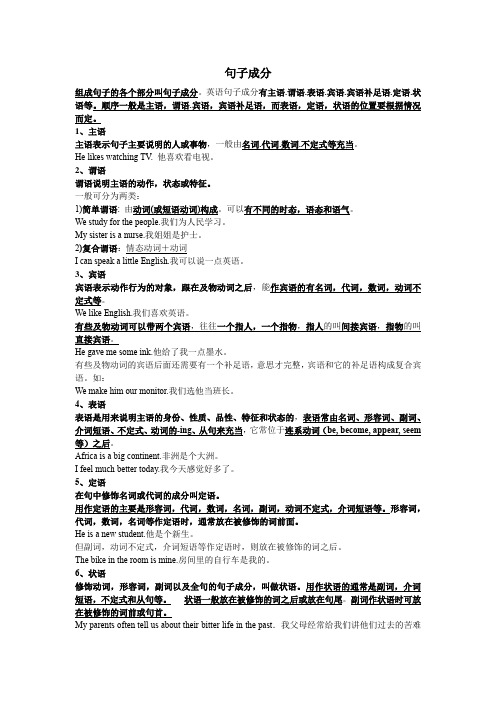
句子成分组成句子的各个部分叫句子成分。
英语句子成分有主语.谓语.表语.宾语.宾语补足语.定语.状语等。
顺序一般是主语,谓语.宾语,宾语补足语,而表语,定语,状语的位置要根据情况而定。
1、主语主语表示句子主要说明的人或事物,一般由名词.代词.数词.不定式等充当。
He likes watching TV. 他喜欢看电视。
2、谓语谓语说明主语的动作,状态或特征。
一般可分为两类:1)简单谓语: 由动词(或短语动词)构成。
可以有不同的时态,语态和语气。
We study for the people.我们为人民学习。
My sister is a nurse.我姐姐是护士。
2)复合谓语:情态动词+动词I can speak a little English.我可以说一点英语。
3、宾语宾语表示动作行为的对象,跟在及物动词之后,能作宾语的有名词,代词,数词,动词不定式等。
We like English.我们喜欢英语。
有些及物动词可以带两个宾语,往往一个指人,一个指物,指人的叫间接宾语,指物的叫直接宾语。
He gave me some ink.他给了我一点墨水。
有些及物动词的宾语后面还需要有一个补足语,意思才完整,宾语和它的补足语构成复合宾语。
如:We make him our monitor.我们选他当班长。
4、表语表语是用来说明主语的身份、性质、品性、特征和状态的,表语常由名词、形容词、副词、介词短语、不定式、动词的-ing、从句来充当,它常位于连系动词(be, become, appear, seem 等)之后。
Africa is a big continent.非洲是个大洲。
I feel much better today.我今天感觉好多了。
5、定语在句中修饰名词或代词的成分叫定语。
用作定语的主要是形容词,代词,数词,名词,副词,动词不定式,介词短语等。
形容词,代词,数词,名词等作定语时,通常放在被修饰的词前面。
英语句子成分和句型结构
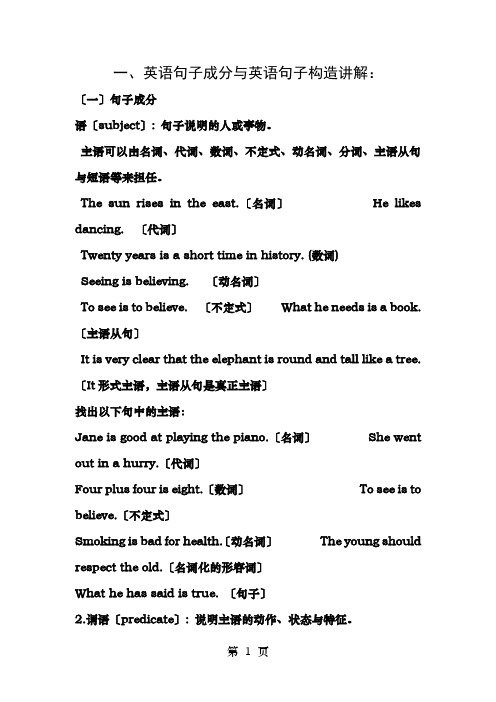
一、英语句子成分与英语句子构造讲解:〔一〕句子成分语〔subject〕: 句子说明的人或事物。
主语可以由名词、代词、数词、不定式、动名词、分词、主语从句与短语等来担任。
The sun rises in the east.〔名词〕He likes dancing. 〔代词〕Twenty years is a short time in history. (数词)Seeing is believing. 〔动名词〕To see is to believe. 〔不定式〕What he needs is a book. 〔主语从句〕It is very clear that the elephant is round and tall like a tree. 〔It形式主语,主语从句是真正主语〕找出以下句中的主语:Jane is good at playing the piano.〔名词〕She went out in a hurry.〔代词〕Four plus four is eight.〔数词〕To see is to believe.〔不定式〕Smoking is bad for health.〔动名词〕The young should respect the old.〔名词化的形容词〕What he has said is true. 〔句子〕2.谓语〔predicate〕: 说明主语的动作、状态与特征。
简单谓语:由动词或动词词组组成I saw the flag on the top of the hillHe looked after two orphans.复合谓语:由情态动词或助动词+动词;He can speak English well.She doesn’t seem to like dancing.找出以下句中的谓语〔注:只有动词才可作谓语。
〕:1. We love China.2. We have finished reading this book.3. He can speak English.4. She seems tired.语〔predicative〕: 系动词之后的成分,表示主语的性质、状态与特征。
英语句子成分及五大基本句型精讲
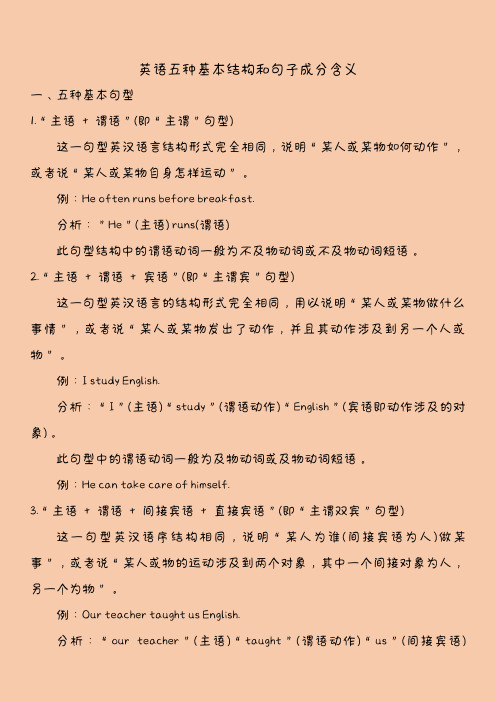
英语五种基本结构和句子成分含义一、五种基本句型1.“主语+ 谓语”(即“主谓”句型)这一句型英汉语言结构形式完全相同,说明“某人或某物如何动作”,或者说“某人或某物自身怎样运动”。
例:He often runs before breakfast.分析:”He”(主语) runs(谓语)此句型结构中的谓语动词一般为不及物动词或不及物动词短语。
2.“主语+ 谓语+ 宾语”(即“主谓宾”句型)这一句型英汉语言的结构形式完全相同,用以说明“某人或某物做什么事情”,或者说“某人或某物发出了动作,并且其动作涉及到另一个人或物”。
例:I study English.分析:“I”(主语)“study”(谓语动作)“English”(宾语即动作涉及的对象)。
此句型中的谓语动词一般为及物动词或及物动词短语。
例:He can take care of himself.3.“主语+ 谓语+ 间接宾语+ 直接宾语”(即“主谓双宾”句型)这一句型英汉语序结构相同,说明“某人为谁(间接宾语为人)做某事”,或者说“某人或物的运动涉及到两个对象,其中一个间接对象为人,另一个为物”。
例:Our teacher taught us English.分析:“our teacher”(主语)“taught”(谓语动作)“us”(间接宾语)“English”(直接宾语)。
4.“主语+ 谓语+ 宾语+ 宾语补足语”(即“主谓宾宾补”句型)这一句型说明“某人或某物要求(使、让)某人做什么”或“某人感觉某人或物怎么样”。
例:Our teacher asks us to write a short story..分析:“our teacher”(主语)“asks”(谓语动作)“us”(宾语即动作涉及的对象)“to write a short story”(补语--补充说明宾语做什么)。
5.“主语+ 系动词+ 表语”(即“主系表”句型)这一句型用以说明“某人(某物、某事、某种概念)具有什么特征或处于什么状态”。
英语句子成分和英语句子结构
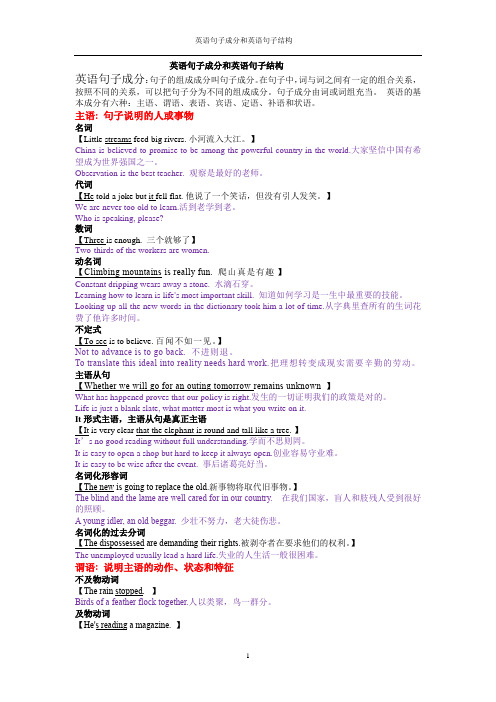
英语句子成分和英语句子结构英语句子成分:句子的组成成分叫句子成分。
在句子中,词与词之间有一定的组合关系,按照不同的关系,可以把句子分为不同的组成成分。
句子成分由词或词组充当。
英语的基本成分有六种:主语、谓语、表语、宾语、定语、补语和状语。
主语: 句子说明的人或事物名词【Little streams feed big rivers. 小河流入大江。
】China is believed to promise to be among the powerful country in the world.大家坚信中国有希望成为世界强国之一。
Observation is the best teacher. 观察是最好的老师。
代词【He told a joke but it fell flat. 他说了一个笑话,但没有引人发笑。
】We are never too old to learn.活到老学到老。
Who is speaking, please?数词【Three is enough. 三个就够了】Two-thirds of the workers are women.动名词【Climbing mountains is really fun. 爬山真是有趣】Constant dripping wears away a stone. 水滴石穿。
Learning how to learn is life's most important skill. 知道如何学习是一生中最重要的技能。
Looking up all the new words in the dictionary took him a lot of time.从字典里查所有的生词花费了他许多时间。
不定式【To see is to believe. 百闻不如一见。
】Not to advance is to go back. 不进则退。
To translate this ideal into reality needs hard work.把理想转变成现实需要辛勤的劳动。
英语句型结构与句子成分划分
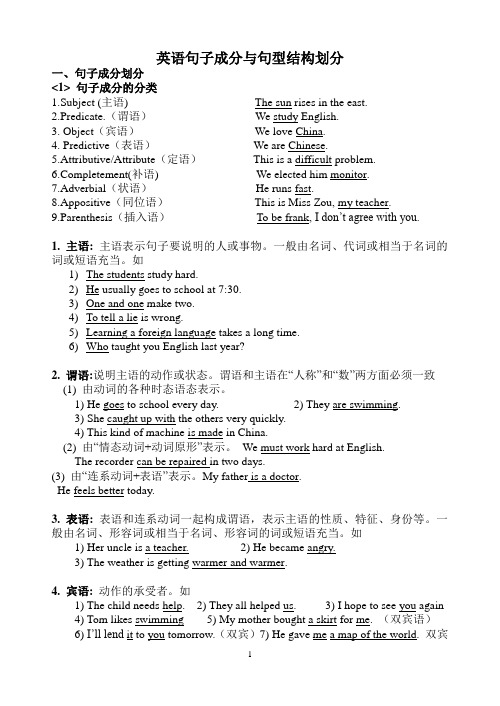
英语句子成分与句型结构划分一、句子成分划分<1> 句子成分的分类1.Subject (主语) The sun rises in the east.2.Predicate.(谓语)We study English.3. Object(宾语)We love China.4. Predictive(表语)We are Chinese.5.Attributive/Attribute(定语)This is a difficult problem.pletement(补语) We elected him monitor.7.Adverbial(状语)He runs fast.8.Appositive(同位语)This is Miss Zou, my teacher.9.Parenthesis(插入语)To be frank, I don’t agree with you.1. 主语:主语表示句子要说明的人或事物。
一般由名词、代词或相当于名词的词或短语充当。
如1)The students study hard.2)He usually goes to school at 7:30.3)One and one make two.4)To tell a lie is wrong.5)Learning a foreign language takes a long time.6)Who taught you English last year?2. 谓语:说明主语的动作或状态。
谓语和主语在“人称”和“数”两方面必须一致(1) 由动词的各种时态语态表示。
1) He goes to school every day. 2) They are swimming.3) She caught up with the others very quickly.4) This kind of machine is made in China.(2) 由“情态动词+动词原形”表示。
英语句子成分和英语句子结构讲解及练习
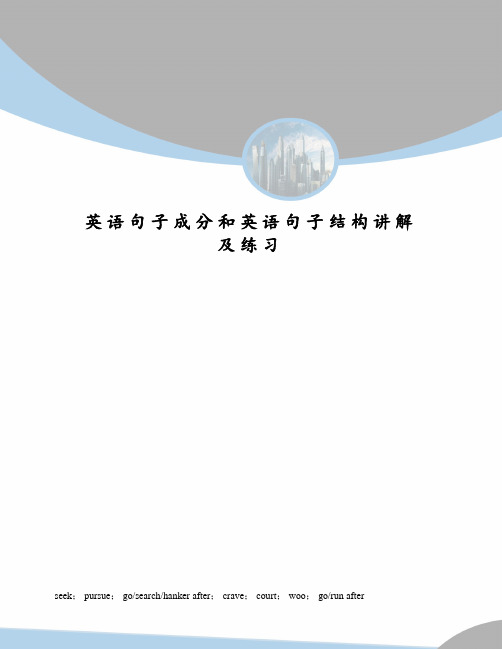
英语句子成分和英语句子结构讲解及练习seek; pursue; go/search/hanker after; crave; court; woo; go/run after英语句子成分和英语句子结构讲解及练习简单句的五个基本句型主语+不及物动词Shecame..主语+及物动词+宾语ShelikesEnglish.主语+系动词+主语补语Sheishappy.主语+动词+间接宾语+直接宾语ShegaveJohnabook.Sheboughtabookforme.主语+动词+宾语+宾语补语Shemakeshermotherangry.Theteacheraskedmetoreadthepassage.There+beThereliesabookonthedesk.主谓宾名/代--动词--名/代we--saw--you.we--did--thework.主系表名/代-系动词-形容次/名词/代词youarebeautifulyouseemsworried.youareastufent.相同点都三部分,主语也一样.不同动词和系动词,时态一样,否定式不同.动词加助动词,系动词不用.表语可以是形容词,宾语不行.只有宾语有补足语2、句子成分:英语句子成分分为七种:主语、谓语、宾语、定语、状语、表语、宾语补足语.1、主语是句子所要说的人或事物,回答是“谁”或者“什么”.通常用名词或代词担任.如:I’mMissGreen.我是格林小姐2、谓语动词说明主语的动作或状态,回答“做什么”.主要由动词担任.如:Jackcleanstheroomeveryday.杰克每天打扫房间3、表语在系动词之后,说明主语的身份或特征,回答是“什么”或者“怎么样”.通常由名词、代词或形容词担任.如:MynameisPingping.我的名字叫萍萍4、宾语表示及物动词的对象或结果,回答做的是“什么”.通常由名词或代词担任.如:Hecanspelltheword.他能拼这个词有些及物动词带有两个宾语,一个指物,一个指人.指物的叫直接宾语,指人的叫间接宾语.间接宾语一般放在直接宾语的前面.如:Hewrotemealetter.他给我写了一封信有时可把介词to或for加在间接宾语前构成短语,放在直接宾语后面,来强调间接宾语.如:Hewrotealettertome.他给我写了一封信5、定语修饰名词或代词,通常由形容词、代词、数词等担任.如:Shanghaiisabigcity.上海是个大城市6、状语用来修饰动词、形容词、副词,通常由副词担任.如:Heworkshard.他工作努力7、宾语补足语用来说明宾语怎么样或干什么,通常由形容词或动词充当.如:Theyusuallykeeptheirclassroomclean.他们通常让教室保持清洁/Heoftenhelpsmedomylessons.他常常帮我做功课/ TheteacherwantedmetolearnFrenchallbymyself.老师要我自学法语8☆同位语通常紧跟在名词、代词后面,进一步说明它的情况.如:WhereisyourclassmateTom你的同学汤姆在哪里1.主语subject:句子说明的人或事物.Thesunrisesintheeast名词Helikesdancing.代词Twentyyearsisashorttimeinhistory.数词Seeingisbelieving.动名词Toseeistobelieve.不定式Whatheneedsisabook.主语从句Itisveryclearthattheelephantisroundandtalllikeatree.It形式主语,主语从句是真正主语一指出下列句中主语的中心词①Theteacherwithtwoofhisstudentsiswalkingintotheclassroom.②Thereisanoldmancominghere.③Theusefuldictionarywasgivenbymymotherlastyear.④Todotoday'shomeworkwithouttheteacher'shelpisverydifficult.谓语predicate:是对主语加以陈述,表示主语的行为或状态,常用动词或者动词词组担任,放在主语的后面.WestudyEnglish.Heisasleep.二.选出句中谓语的中心词①Idon'tlikethepictureonthewall.A.don'tB.likeC.pictureD.wall②Thedaysgetlongerandlongerwhensummercomes.A.getB.longerC.daysD.summer③DoyouusuallygotoschoolbybusA.DouallyC.goD.bus④Therewillbeameetingatthelibrarythisafternoon.A.willbeB.meetingC.thelibraryD.afternoon3.表语predicative:系动词之后的成分,表示主语的性质、状态和特征.Heisateacher.名词Youdon’tlook it.代词Fiveandfiveisten.数词Heisasleep.形容词Hisfatherisin.副词Thepictureisonthewall.介词短语Mywatchisgone/missing/lost.形容词化的分词Thequestioniswhethertheywillcome.表语从句常见连系动词“存在”类:表示存在或具有某种特征或状态.这类连系动词强调“存在”.常见的有:be是,look看起来,feel摸上去,seem似乎是,appear似乎、显得,prove证明是,smell闻起来,taste尝起来,sound听起来等.例如:Thestorysoundstrue.Thoseorangestastegoodstar.2.“持续”类:表示某种情况或状态的持续.这类连系动词强调“持续”.常见的有:remain依然,keep保持,stay保持,continue继续、仍旧,stand处于某状况或情形等.例如:Whydon'tyouputthemeatinthefridgeItwillstayfreshforseveraldays.It'salreadyteninthemorning.Thestoreremainsclosed.What'sthematter3.“变化”类:表示由一种情况或状态变化成另一种情况或状态.这类连系动词强调“变化”后的情况或状态.常见的有:become变成,turn变成,grow变得,get变得等.例如:Putthefishinthefridge,oritwillgobadinhotweather.三挑出下列句中的表语①Theoldmanwasfeelingverytired.②WhyisheworriedaboutJim③Theleaveshaveturnedyellow.④SoonTheyallbecameinterestedinthesubject.⑤Shewasthefirsttolearnaboutit.①tired ②worried ③yellow ④interested ⑤first4.宾语:1动宾表示行为的对象,常由名词或者代词担任.放在及物动词或者介词之后.如:IlikeChina.名词Hehatesyou.代词Howmanydoyouneed Weneedtwo.数词Ienjoyworkingwithyou.动名词Ihopetoseeyouagain.不定式Didyouwritedownwhathesaid宾语从句2介词后的名词、代词和动名词-----介宾AreyouafraidofthesnakeUnderthesnow,therearemanyrocks.3双宾语-----间宾指人和直宾指物Hegavemeabookyesterday.Givethepoormansomemoney四挑出下列句中的宾语①Mybrotherhasn'tdonehishomework.②PeopleallovertheworldspeakEnglish.③Youmustpaygoodattentiontoyourpronunciation.④Howmanynewwordsdidyoulearnlastclass⑤Someofthestudentsintheschoolwanttogoswimming.hishomework ②English ③yourpronunciation ④newwords ⑤togoswimming5.宾补:对宾语的补充,全称为宾语补足语.Weelectedhimmonitor.名词Weallthinkitapity thatshedidn’tcomehere.名词Wewillmakethemhappy.形容词Wefoundnobodyin.副词Pleasemakeyourselfathome.介词短语Don’tlethim dothat.省to不定式Hisfatheradvisedhimtoteachthelazyboyalesson.带to不定式Don’tkeepthelights burning.现在分词I’llhavemybike repaired.过去分词扩展:主补:对主语的补充.Hewaselectedmonitor.Shewasfoundsinginginthenextroom.Hewasadvisedtoteachthelazyboyalesson.五挑出下列句中的宾语补足语①Shelikesthechildrentoreadnewspapersandbooksinthereading-room.②Heaskedhertotaketheboyoutofschool.③Shefounditdifficulttodothework.④TheycallmeLilysometimes.⑤IsawMr.Wanggetonthebus.⑥DidyouseeLiMingplayingfootballontheplaygroundjustnow①toreadnewspapersandbooksinthereading-room ②totaketheboyoutofschool ③Lily ④getonthebus ⑤playingfootballontheplayground划出句中的直接宾语和间接宾语①Pleasetellusastory.②Myfatherboughtanewbikeformelastweek.③Mr.Liisgoingtoteachushistorynextterm.④Hereisapen.GiveittoTom.⑤Didheleaveanymessageforme6.定语:修饰或限制名词或代词的词、词组或句子.Yanlingisachemistryteacher.名词Heisourfriend.代词Webelongtothethirdworld.数词Hewasadvisedtoteachthelazyboyalesson.形容词Themanoverthereismyoldfriend.副词Thewomanwithababyinherarmsismysister.介词TheboysplayingfootballareinClass2.现在分词Thetreesplantedlastyeararegrowingwellnow.过去分词Ihaveanideatodoitwell.不定式YoushoulddoeverythingthatIdo.定语从句六挑出下列句中的定语①TheyuseMr.,Mrs.withthefamilyname.②Whatisyourgivenname③OnthethirdlapareClass1andClass3.④Iamafraidsomepeopleforgottosweepthefloor.⑤Themandownstairswastryingtosleep.①family ②given ③third ④some ⑤downstairs7.状语:用来修饰v.,adj.,adv.,or句子.表示时间、地点、原因、目的、结果、程度、条件、方式和让步.以下例句按上述顺序排列Iwillgotheretomorrow.Themeetingwillbeheldinthemeetingroom.Themeatwentbadbecauseofthehotweather.HestudieshardtolearnEnglishwell.Hedidn’tstudyhard sothathefailedintheexam.Ilikesomeofyouverymuch.Ifyoustudyhard,youwillpasstheexam.Hegoestoschoolbybike.Thoughheisyoung,hecandoitwell.七挑出下列句中的状语①Therewasabigsmileonherface.②Everynightheheardthenoiseupstairs.③HebegantolearnEnglishwhenhewaseleven.④Themanonthemotorbikewastravellingtoofast.⑤Withthemedicineboxunderherarm,MissLihurriedoff.①ontheface ②Everynight ③whenhewaseleven ④fast ⑤Withthemedicineboxunderherarm 八、同位语当一个概念词在前,后面的词、词组或者句子是在解释前者时,而且两者的语法功能相同,后者就是前者的同位语.Mr.Black,ourEnglishteacher,isagoodtennisplayer.我们的英语老师——布莱克先生是个优秀的网球手.Football,theonlyinterestinlife,hasbroughthimmanyfriends.足球----他唯一的爱好,让他结交了许多朋友.YesterdayImetTom,afriendofmybrother's.昨天我遇到了我弟弟的朋友汤姆.That’sherhabit,readinginbed.躺在床上看书是她的习惯.Yoursuggestion,tostrikewhiletheironishot,seemedagoodidea.你建议趁热打铁,这个建议很好. Hegaveordersthattheworkshouldbestartedimmediately.他发出指示要立即开始工作.Youstillhaven’tansweredmyquestionwhyyoudidn’tcometoschoolyesterday.你还没有回答我昨天为什么没有上学.同位语从句常跟在某些名词后,对其作进一步的解释.这些名词包括:fact,doubt,idea,news,hope,indication,decision,possibility,assumption,suggestion,ques tion.这类从句常常有that引导,有时也可以用what,why,whether,when等引导.九插入语插入语是说话者对所表达的意思的补充、强调、解释或者说话的态度,其位置灵活常常用逗号或者破折号分开,并且在语法上不影响其他成份.1.插入语常以副词副词短语、形容词形容词短语、介词短语、短语等形式出现.1常见的副词及短语:indeed,surely,however,obviously,frankly,naturally,luckily/happilyforsb.certainly等.九■Therebe句型拓展:Therebe+句词词组”中,there为虚词,be后面的名词词组为句子的真正主语.该句式在使用时须注意如下几点:★Therebe句式表示“有”时,它表示一种存在关系,通常带有一个地点状语,意为“什么地方时候有……”.句式中的主语只能为表泛指的名词词组,此外,其主语还可以带前置或后置定语.例如:1.Thereisablackboardintheclassroom.2.Therearefiveminutestogo.3.Therearetwooldwomenwaitingforyouatthegate.★在正式文体中,该句式中be动词的单复数形式取决于以下两种情况:1该句式中只有一个主语,主语为单数时,be动词用单数;主语若为复数,be动词也用复数.2该句式中有几个并列主语,则按就近原则处理,即与靠近be动词的第一个主语保持一致.例如:1.Thereisroomforimprovement.2.Therearethreeapplesonthetable.3.Therewereonlytwopens,adictionaryandatextbookonthedesk.★“Therebe+主语+不定式”中,不定式可以有主动和被动两种形式,不过在口语中主动形式更为常见.例如:1.Thereisalettertotypetoday.2.Thereisnotimetolose.3.Therearemanythingstobedonenow.★Therebe句式中,be动词有各种变化形式.1be动词有时态变化,可以为一般现在时、一般过去时、现在完成时、过去完成时、将来时等.例如:1.Therearealotofpeopleinthemeeting-room.2.Therewaslittleleft.3.Therehavebeenmanysuchtrafficaccidentsinthepastfewyears.4.Whenhegotthere,hefoundtherehadbeennoonewaitingforhimintheroom.5.Withoutair,therewouldbenolivingthings.6.Thereisgoingtobeastormtomorrowmorning.2Therebe句式中,be之前可以有情态动词.例如:1.Theremaybesomepeoplewhodon’tlikethefilm.2.Thereusedtobeatempleinthevillage.句子种类一按使用目的可分为陈述句、疑问句、祈使句和感叹句.1陈述句DeclarativeSentences:说明一个事实或陈述一种看法. Lighttravelsfasterthansound.光比声速度快.Thefilmisratherboring.这部电影很乏味.Ihaven’tgotacamera.我没有相机.Theyhavenevermetbefore.他们以前从没见过面.疑问句InterrogativeSentences:提出问题.有以下四种:a.一般疑问句GeneralQuestions:Canyoufinishtheworkintime你能按时完成工作吗b.特殊疑问句WQuestions;HQuestionsWheredoyoulive 你住那儿Howdoyouknowthat 你怎么知道那件事c.选择疑问句AlternativeQuestions:Doyouwantteaorcoffee你是要茶还是要咖啡d.反意疑问句Tag-Questions:Heknowsher,doesn’the他不认识她,对不对=Doesheknowheryes,hedoes.No,hedoesn’t.3祈使句ImperativeSentences:提出请求,建议或发出命令,例如:Sitdown,please.请坐.Don'tbenervous别紧张4感叹句ExclamatorySentences:表示说话人惊奇、喜悦、愤怒等情绪,例如:Whatgoodnewsitis多好的消息啊HowgoodthenewsisWhatbeautifulflowerstheyare多美丽的花啊HowbeautifultheflowersareHowlovelythechildis多可爱的小孩啊Whatalovelychildheiswhatacutechildheis二句子按其结构可以分为以下三类:1简单句SimpleSentences:只包含一个主谓结构句子叫简单句,例如:Sheisfondofcollectingstamps.她喜欢集邮.Weallstudyhard.我们都努力学习.Ilovesportsverymuch.我非常喜欢运动.Mummadeabeautifulskirtforme.妈妈为我做了一条漂亮的裙子.Weelectedhimourclasspresident.我们选了他做班长.Therearemorethan3000studentsinourschool.我们学校的学生超过3000名.2并列句CompoundSentences:由两个或两个以上的简单句并列连接起来的句子叫并列句. Thefoodwasgood,buthehadlittleappetite.食物很精美,但他却没什么胃口.Let’shurry,orwewillbelate.咱们赶紧点,要不就迟到啦.Hestudiedhard,andhepassedtheexam.他努力学习并通过了考试.Hefeltnofear,forhewasverybrave.他很勇敢,毫不畏惧.Hewassick,sotheywerequiet.他病了,所以他们很安静.3复合句ComplexSentences:包含一个主句从句和一个或几个从句的句子叫复合句,从句由从属连词引导,例如:Thefilmhadbegunwhenwegottothecinema.我们到达电影院的时候,电影已经开演了.Doyouknowthemanwhoisinthecar你认识坐在汽车里的人吗Whathesaidisnottrue.他说的不是实话.Iknowit’sdifficulttomasteraforeignlanguage.我知道学好一门外语不容易.Thequestioniswhetherhewilljoinusnexttime.问题是下次他是否跟我们一起干. TheideathatIraqcouldbetakenwithinaweekortwowasanunderestimation.伊拉克可以在一两周内就可以拿下的这一想法是估计不足的想法.Togetintouniversity=Ifyouwanttogetintouniversityyouhavetopassanumberofexams.进入大学,你必须通过一系列的考试.元音和辅音的定义:发音时声带振动,呼出的气流通过口腔时不受阻碍,这样形成的语音称为元音.不论声带振动与否,发音时呼出的气流通过口腔或鼻腔时受到一定的阻碍,这样形成的语音称为辅音.发音时声带不振动的辅音称为清辅音.发音声带振动的辅音称为浊辅音.巧记48个国际音标单元音共十二,四二六前中后双元音也好背,合口集中八个辅音共计二十八八对一清又七浊,四个连对也包括.有气无声清辅音,有声无气浊辅音,发音特点应掌握1.音标必须写在括号里,常用的音标括号有斜头和平头两种,其上端不顶第一线,大致与大写字母相齐,下端在第三格的中2.音标没有书写体,也没有大小写,因此书写时必须和印刷体一样,直上直下,没有斜度,其书写规格如下所列.3.下面几个音标是最容易写错的,一定要注意:ai和au不要写成Ai和Au,A:不要写成a:.在打字的时候,不要用a来代替A,把A:打成a:,也不要用g来代替G,把GE:l打成gE:l.4.音标没有书写体,也没有大小写,因此书写时必须和印刷体一样,直上直下,没有斜度,其书写规格如下页所列元音音标学习元音概述:元音是有噪音的语音.形成元音时,声带振动,气流经由咽腔和口腔逸出时,不受到任何阻碍,没有可以听得到的摩擦声.英语里共有20个元音单元音12个,双元音8个.•元音之间的差异,是由发音时各发音器官所采取的不同位置形成的.所谓“不同位置”,指的是舌头的高低与前后,牙床的开合程度,以及唇形的大小和圆扁.但其中决定的因素是舌头的位置:舌头是在口腔的前部、中部或者后部,决定所发的音是前元音、中元音还是后元音;舌身隆起的高度以及舌的哪一部分隆起最高,决定发出的元音是开口元音、半开元音、合口元音、还是半合元音.牙床开合的程度是由舌位的高低所决定的,而双唇的圆扁和大小对形成不同的元音也有相当的影响.因此,描述一个元音的发音部位,主要是描述它的舌位和唇形.Lesson1元音i:i:学习i:发这个音的字母和字母组合eeaeee:mebesheheweeveningee:sweetbeesweepsheepseesleepthreegreenea:meatleafseapeateacheatclean根据发音规则,圈出下列单词中元音字母组合发音相同的两个词.1.seatrainbeancat2.giftfeetteacherd3.pigstartreejeep4.sweetseafishthei发这个音的字母和字母组合ieyeyay•i:pigfishinfifteensixshipthin•e:beginbehindjacketbasketball•y:happyheavybusylorrycarrysunny•lovelystudythirstytwentythirtywindyrainy•ey:monkeymoney•ay:SundaySaturdayFriday根据发音规则,圈出每组中元音字母发音不相同的单词.•1.sofasitkicklip•2.inkgiftjamship•3.handpicturebigsister•4.hotlickpigjelly:发这个音的字母和字母组合erirurearorer:herservetermir:birdgirlskirtfirstdirtyskirtshirtur:nurseThursdayturtlepurplecurtainear:earlylearnor:wordworkworld根据发音规则,圈出每组中元音字母组合发音相同的单词.1.thirtybeerthirstywheat2.bankkinghernurse3.turtlebirdrabbitknee4.roomrunshirtterm发这个音的字母和字母组合ureeraroraeure:pictureer:teacherbrotherdinnerfathersisterar:sugaror:doctora:pandaaboutabovecamerasofaChina根据发音规则,找出发的2个单词写在后面的横线上.1.mothersofaroadsmile2.sitfathersisterfood3.hairdeertigerChina4.sugarsoonearleaderLesson2音标:u:u学习发这个音的字母和字母组合oao:foxcoffeedogshopdogdoctorlonga:watch根据发音规则,找出发:的2个单词写在后面的横线上.1.doctorteacherboxclothes2.coldzooclockdog3.lovebosslotviolin4.watchbeachfoxgirlu:发这个音的字母和字母组合ooouio:dowhowhoseoo:foodmoontooui:fruitjuiceu:rulerrude根据发音规则,找出不发u:的单词.1.juicemoonzoopanda2.toothbroomeyespoon3.headbootnoodlespool4.nooncoolbootwatchu发这个音的字母和字母组合ooouo:womanwolf•oo:lookgoodbookfootwoodu:bullbullet•根据发音规则,选出与其它单词元音发音不相同的单词.1.mouthbooklookpull2.pushtapesugarfoot3.woodkindwolfbull4.bulletwoodcookname四.写出单词或音标.•bru:m d: sit b:d•fut wi: dg ′sist •lookdowatergood•toofootclockfirst •worksisterdoctorsea•五.将下列单词与正确的音标用线连起来.•hot blu:•football huk •blue ki:shook futb:l kiss ht Lesson3音标a:Λe练习a:发这个音的字母和字母组合aarauear •a:grassglassclassplantdancefastfatherlastar:carstararmMarchgardendarkscarf au:laughauntear:heart•根据发音规则,圈出发a:的2个单词. 1.armlipdoctorcard•2.cloudcartgardengate3.ballscarfdarktiger•4.joblorryMarchparkΛ发这个音的字母和字母组合ouooouo:soncomecolourlovemoneyu:sunnutjumpgumbusbrushsupperusou:touchcousincountry•根据发音规则,找出每组中发Λ的单词.1.hearcupbedair2.voiceboyduckant3.vasecornbeargun4.cuteboymoneyher发这个音的字母和字母组合aa:dadcapcatbadapplebagflaghandrabbitantblackfathasstandratmap根据发音规则,找出每组中发的单词.1.ratbedfacesport2.hearcupfatpear3.ricebatfingertree4.seayoungknifeapplee发这个音的字母和字母组合eeae:eggbelldesklegpettenpenea:breadheadbreakfast•根据发音规则,找出每组中不发e的单词.1.catwelllegpen2.sweatmappetelephant3.eggtentalldesk4.breadheadbedtoy音标a:Λe练习•一.抄写音标,一个抄写5遍.•a::Λ:•:e:____•二.选出下列没有相同发音的词.•1.cararmfoodgarden•2.truejumpbuscut•3.bagshortmapflag•4.eggpenheadsmall•5.gotclockbelldog•6.rabbitbookwoodfoot•7.ratbatappleten•8.gunstarduckmoneg•三.写出单词或音标.•pa:stru:mswetsit•f tgtcΛpsh:t•bagcarbusbreadstarhead•四.选出下列每题中元音有几种读音,有一种读音的在里画☆,有两种读音的画△,有三种的画◇•1.hatfastcooklast•2.jeepdoorsungum•3.dadcaphandmap•4.starcarcutfrom•5.skirtsheepbirdher•五.改变下列单词的一个字母,使它变成另一个单词•like_________________交通工具•hat________________动物•lake________________食品•nice_______________数字•hot_________________用品•well_______________用品Lesson4元音音标eiaiiau练习ai发这个音的字母和字母组合iyieuy•i:kitebikenicetigerwriteknife•y:bycryflymyskytrywhy•ie:tiepie•uy:buy•根据发音规则,找出每组中发ai的2个单词.•1.ricegoodjamright•2.shipmineice-creammouse•3.cloudsittieeye•4.writesmalltenniskitei发这个音的字母和字母组合oioy•oi:oilboilcoin•oy:boytoy根据发音规则,找出每组中发i的2个单词.1.soilhearsoycold2.rabbitbedboynoise3.walkvoiseboilword4.teaenjoytoymilkau发这个音的字母和字母组合ouowou:housemousemouthtrousersow:flowercowhownowdown•根据发音规则,选出不发au的单词. 1.mousecloudarmclown2.teachertrouserscowmouth3.towndanceflowerhouse4.towerblousenowbaby四.把下列单词下正确的音标连接起来•bowbau•gatepai•traygeit•pietrei•poisonpizn五.看图、填空、标号•h___t→s__n→e____s__r→•r__l____→c__k___→m____thLesson5元音音标uieu的练习u发这个音的字母和字母组合ooaowo:noserosepoenoveroa:boatcoatsoapgoatow:showwindowsnowbowl根据发音规则,圈出每组中发u的2个单词. 1.coatgoattreeriver2.makewindowkniferoad3.yourwhiterowcoat4.boathennoselampi发这个音的字母和字母组合eareerear:earhearteareer:deerbeer根据发音规则,圈出每组中发i的1个单词.1.bearbeerfairtail2.noodlespairnearcome3.horseneartowerair4.ringkingherethreee发这个音的字母和字母组合airearair:hairchairpairear:pearbearwear根据发音规则,圈出每组中发e的1个单词.1.bearideapineappletail2.noodlespairclimbcome3.horsehousetowerair4.ringkingharethreeu发这个音的字母和字母组合oorourureoor:poorour:tourure:surepure根据发音规则,圈出每组中发u的1个单词.1.cleartouristpineappletail2.noodlespairclimbfury3.beardcuretowerair4.voicekingpureengineer辅音爆破音:ptkbdg摩擦音:fvszθe破擦音:trdrtsdzt∫t3鼻辅音:mnη舌侧音:1出现在元音之前叫作清晰舌边音2出现在辅音及单词末尾时叫作模糊舌边音半元音:擦音中气流较弱,摩擦较小,介于元音跟辅音之间的音wj •3∫•hrLesson6辅音音标pbtd练习p发这个音的字母和字母组合pppp:pianopandaparrotpetshipsheeppigstoppp:applehappy根据发音规则,圈出没有发p的单词.1.shipphonesleeppear2.pickpenbigpineapple3.taxiparrotsheeppig4.pandaponypettruckb发这个音的字母和字母组合bbbb:bookballbirdbigboybagbananabb:rubberrabbitcabbage根据发音规则,圈出发b的2个单词.1.cabgiftbeachlove2.petgodtubbed3.weatherboybusmake4.rabbitreaddressbabyt发这个音的字母和字母组合tttt:tableteataxicatratfatticketTt:buttermatter根据发音规则,圈出没有发t的1个单词.1.taxifatbagtoy2.hatticketteaduck3.pocketpacketcatraind发这个音的字母和字母组合dedd:duckseeddoordeskdayredheadbedreadcolded:smiledopenedplayed根据发音规则,圈出没有发d的1个单词.1.bedclotheshand2.dogcoldfive3.danceduckgrape音标pbtd练习一.抄写音标,一个抄写5遍.•p:b:t:d:_______二.选出下列没有相同发音的词•1.pearshipcoatpig•2.taxibeancabcabbage•3.hatseaticketwallet•4.seeddancehandfull•5.pickpensitpineapple•6.coldfinddoorchair•7.clothpurplepoolpush•8.eatfanquietset三.写出单词或音标.•p ndkΛtdi:pklaud•applepearrabbitread四.改变下列单词的一个字母,使它变成另一个单词.•short→_____________衣物sea→_________________感官动词•pet→______________蔬菜ten→___________________动物Lesson7辅音音标kgsz学习g发这个音的字母和字母组合gggg:glassgolfgetgirlbaggoatflaggg:egg根据发音规则,圈出发g的单词.gasdrivegumgiveviolinbagjeansorangelogbridgeguesstankgradelonglanguages发这个音的字母和字母组合scssces:starsunsnakeseaseec:pencilcitycedarceilingcelebratess:grassglassclassbossce:faceracericenice根据发音规则,圈出每组中2个发s的单词.1.whosejuicelickstudent2.thosecasescarfshoes3.spacenosesciencemeat4.tearspiecebusnoseLesson8辅音音标∫3t∫d3练习3发这个音的字母和字母组合ss:television,usually,Asiameasureagarage,anunusualcollision;agreatdecision;mypleasure根据发音规则,圈出下列单词中发3的2个单词.1.shellshipgaragedesk2.truckshirtpleasureship3.brushcasualsheepsleep4.heroshapeleisureshelft∫发这个音的字母和字母组合chtchch:teacherpeachcherrychairtch:watchmatch根据发音规则,找出下列单词中发t∫的单词,并抄下来. chairdumplingbeachcheesenightshemonkeyChinachurchtheseflowereggdreamsharkchickcatchLesson9音标fvθe的练习v发这个音的字母和字母组合vvev:videovasevestve:fiveloveviolin根据发音规则,在不发v的单词上打×violinmovevotewindowvanvolcanowhitewomanvictorywetwavevasee发这个音的字母和字母组合thth:fathermotherbrotherclothesweather根据发音规则,圈出每组中发e的1个单词. 1.thansisterbrotherthree2.weatherthanknightgood3.tielookteeththey4.thinfatherthroatwatchLesson10辅音音标tsdztrdr的练习dz发这个音的字母和字母组合dsdesds:seedswoodsfriendsbirdsbedsdes:rides根据发音规则,找出发dz的5个单词写在后面的横线上. coatshandscatskitesbedswordspetskidsseatshorsesandsgatestr发这个音的字母和字母组合trtr:treetrucktrousersstrawberrytrick根据发音规则,找出没有发tr的3个单词写在后面的横线上. seatstrucktraintrashtractordrinkstreetdrugtrousersdr发这个音的字母和字母组合drdr:drawdrinkdriverdragondry根据发音规则,找出每组中发dr的2个单词写在后面的横线上.1.dreamduckdressrain2.ratdraindrugdoor3.treetreasuredrawerdrink4.truckdragondishdrumLesson11辅音音标hrlm的练习r发这个音的字母和字母组合rrrwrr:riceroomrideroadroserr:mirrorcarrotparrotwr:writewrongwrap根据发音规则,选出发r的单词,打√.1.breaddriverwrongrainworker2.riverfatherrobotropesister3.writefruitrabbitcrowndruml发这个音的字母和字母组合lll•l:looklightlockluckyliontail•ll:ballpulldollartell根据发音规则,选出每组中不发l的单词.•mpnailflagwoman•2.yellowfruitlionlychee•3.grapebulllaughlake•4.dumplingmoonwheelwhaleLesson12音标nηwj的练习n发这个音的字母和字母组合nkngnn:nosenetnutbanananoodlestrainrainplanedownkn:kneeknifeknockgn:sign根据发音规则,找出发n的单词并抄下来.1.mirrorwheelyesknock2.mallhenlaughnut3.earringsplanewingbreadη发这个音的字母和字母组合nngn:inkbanktankfingerng:singhangsongkingreadingrunning根据发音规则,从下列每组中找出2个发η的单词. 1.netringfingermeat2.tennismouthsongswing3.dumplingwingrunnail4.hangswiminknotew发这个音的字母和字母组合w:winterwindowwatchwaterwellwouldwh:whitewherewhichwhenwhywheelwhale根据发音规则,选出每组中不发w音的1个单词.1.woodwritewheelwhich2.wheatsnowwetwoman3.whitewindownowwhy4.whalewaterwatchrowj发这个音的字母和字母组合yy:yo-yoyogurtyardyesyouyour根据发音规则,找出发j的单词写在下面横线上. cryyouyourskyyellowlorry moneyjellytoyboyyogurtsoy。
英语句子成分与基本句式结构

四、表语
位于连系动词的后面,用来说明主语的身份、 特征、状态等。构成主系表结构。
例句: 1. This is an English book. 2. You look happy today. 3. They are from America. 4. I don’t feel well today.
英语句子成分和基本句型
句子成分
句子成分: 组成句子的各个部分。 主语 谓语 宾语 表语
状语 定语 补语 同位语
一、主语
句子所陈述的主体,一般位于句首,指动作 的发出者。
例句: 1. You are my friend. 2. My father is a teacher. 3. These girls like English.
第四种:主语+谓语+宾语+宾语补足语.
例句: 1. I can make you happy. 2. They want me to sing. 3. We call him Mr. Smith. 4. The sun keeps us warm.
第五种:主语+连系动词+表语.
例句: 1. My father is happy. 2. She looks beautiful. 3. Her face turns red. 4. My dream(梦想) is to be a scientist.
五、定语
用来修饰、限定、说明名词或代词的品质与特 征的词。
例句: 1. This is a red car. 2. The tall boy is my friend. 3. Harbin is a beautiful city. 4. Mr. Black is a kind and interesting teacher.
英语句子成分及结构

They made paper flowers. 宾语(名词作定语)
The boys in the room are in Class Three Grade One. (介词短语作定语)
I have something to do. (不定式作定语)
这类动词叫做及物动词。
如:1. Who │knows │the answer? 2. He │admits │that he was mistaken
有些及物动词可以有两个宾语, 这两个宾语通常一个指人 (间接宾语); 一个指物 (直接宾语)。 eg:give / pass / bring / show Give me a cup of tea please./ Pass our English teacher the book./ Bring it to me, please. / Show this house to Mr. Smith. 1.She │ordered │herself │a new dress. 2. He │brought │you │a dictionary. A:动词后加to give 给 show给……看 send寄,打电报 bring带…… read读…… pass递给…… lend借给…… leave留给…… hand交给…… tell告诉…… return把……还给… write给……写信 throw扔…… promise答应…… refuse 拒绝 B:动词后加for make生产,制造…… buy买 do做 get得到 play演奏 order命令 sing唱歌
2 谓语
说明主语“做什么”,“是什么”或“怎么样”。 谓语必须用动词,放在主语后面, 且主谓一致。
英语句子成分及句子结构
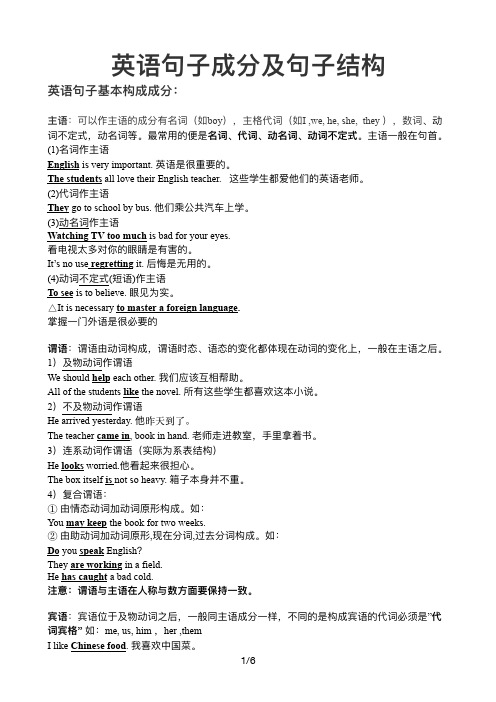
英语句⼦成分及句⼦结构英语句⼦基本构成成分:主语:可以作主语的成分有名词(如boy),主格代词(如I ,we, he, she, they ),数词、动词不定式,动名词等。
最常⽤的便是名词、代词、动名词、动词不定式。
主语⼀般在句⾸。
(1)名词作主语English is very important. 英语是很重要的。
The students all love their English teacher. 这些学⽣都爱他们的英语⽼师。
(2)代词作主语They go to school by bus. 他们乘公共汽⻋上学。
(3)动名词作主语Watching TV too much is bad for your eyes.看电视太多对你的眼睛是有害的。
It’s no use regretting it. 后悔是⽆⽤的。
(4)动词不定式(短语)作主语To see is to believe. 眼⻅为实。
△It is necessary to master a foreign language.掌握⼀⻔外语是很必要的谓语:谓语由动词构成,谓语时态、语态的变化都体现在动词的变化上,⼀般在主语之后。
1)及物动词作谓语We should help each other. 我们应该互相帮助。
All of the students like the novel. 所有这些学⽣都喜欢这本⼩说。
2)不及物动词作谓语He arrived yesterday. 他昨天到了。
The teacher came in, book in hand. ⽼师⾛进教室,⼿⾥拿着书。
3)连系动词作谓语(实际为系表结构)He looks worried.他看起来很担⼼。
The box itself is not so heavy. 箱⼦本身并不重。
4)复合谓语:①由情态动词加动词原形构成。
如:You may keep the book for two weeks.②由助动词加动词原形,现在分词,过去分词构成。
英语句子结构和句子成分

一般疑问句
特殊疑问句
选择疑问句
反意疑问句
一般疑问句
①用来询问一件事,答案通常是yes或no,注意语序。 —Do you often speak English at school ? —Yes, I do. /No, I don’t.
②否定式的一般疑问句。此类一般疑问句表示反问或惊讶,通常用be动词、 情态动词或助动词后加not的缩写形式构成,放在句首。
③一用般疑ye问s, 句no也之可外用的其词他回表答示的肯一定点般或击疑否此问定处句的。词回答,如:certainly, sure, of course, I think so, all r输igh入t,文wi本th信p息leasure, perhaps 等代替yes, certainly not, not at all, never, I’m sorry, not yet, I’m afraid not 等代替no. 如: —Would you mind my joining your talk/discussion? —Of course not.
带有宾语补足语的一般句型为:某些及物动词(如make等+宾语 +宾补)。
宾补可由名词、形容词、副词、不定式、分词、介词短语和从句充当。
You mustn’t force him to lend his m输o入n标e题y文t本o信y息ou.(不定式短语)
We
saw
her
entering
the
room.(现在分词) 标题数字等都可以通过点击和重新 输入进行更改。文字数字大小颜色
We found everything in the lab in g参o考o此模d板order.(介词短语)
英语句子成分及五大句型结构研究
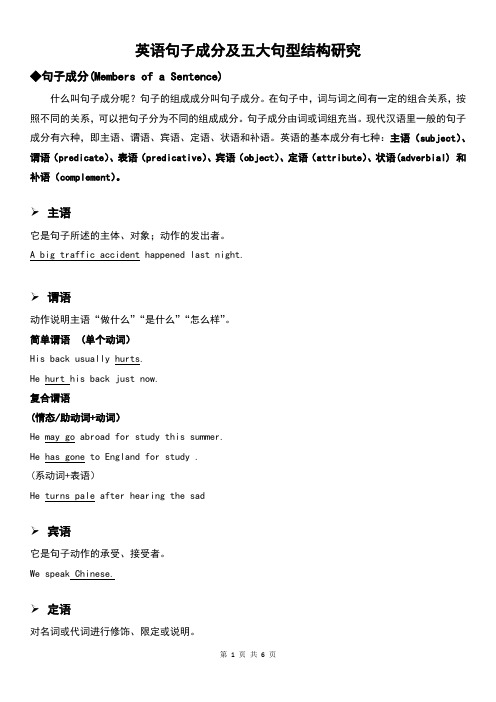
◆五种句子结构的讲解
考点1:基本句型一:主语+谓语 (S+V )
例句:1. The sun │was shining. 太阳在照耀着。
2. The moon │rose. 月亮升起了。
考点2:基本句型 二: S +V+ O(主+谓+宾)
例句:1. Who │knows │the answer? 谁知道答案?
英语句子成分及五大句型结构研究
◆句子成分(Members of a Sentence)
什么叫句子成分呢?句子的组成成分叫句子成分。在句子中,词与词之间有一定的组合关系,按照不同的关系,可以把句子分为不同的组成成分。句子成分由词或词组充当。现代汉语里一般的句子成分有六种,即主语、谓语、宾语、定语、状语和补语。英语的基本成分有七种:主语(subject)、谓语(predicate)、表语(predicative)、宾语(object)、定语(attribute)、状语(adverbial) 和补语(complement)。
2. She │smiled │her thanks. 她微笑表示感谢。
3. He │has refused │to help them. 他拒绝帮他们。
考点3:基本句型 三: S + V + IO + DO(主+谓+间宾+直宾)
有些及物动词可以有两个宾语,如:give给,pass递,bring带,show显示。这两个宾语通常一个指人,为间接宾语;一个指物,为直接宾语。间接宾语一般位于直接宾语之前。
A.“I”B.“often”C.“ride”D.“my”
( )6.He keeps exercising every dayno matter what the weather is like.
英语句子成分及结构
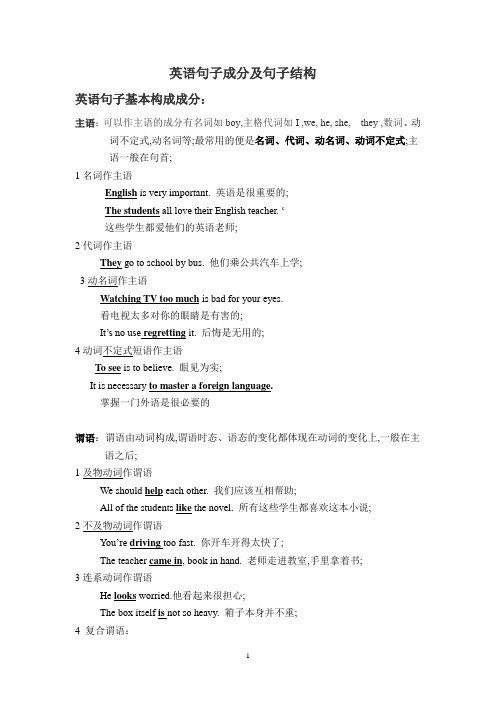
英语句子成分及句子结构英语句子基本构成成分:主语:可以作主语的成分有名词如boy,主格代词如I ,we, he, she, they ,数词、动词不定式,动名词等;最常用的便是名词、代词、动名词、动词不定式;主语一般在句首;1名词作主语English is very important. 英语是很重要的;The students all love their English teacher. ‘这些学生都爱他们的英语老师;2代词作主语They go to school by bus. 他们乘公共汽车上学;3动名词作主语Watching TV too much is bad for your eyes.看电视太多对你的眼睛是有害的;It’s no use regretting it. 后悔是无用的;4动词不定式短语作主语To see is to believe. 眼见为实;It is necessary to master a foreign language.掌握一门外语是很必要的谓语:谓语由动词构成,谓语时态、语态的变化都体现在动词的变化上,一般在主语之后;1及物动词作谓语We should help each other. 我们应该互相帮助;All of the students like the novel. 所有这些学生都喜欢这本小说;2不及物动词作谓语You’re driving too fast. 你开车开得太快了;The teacher came in, book in hand. 老师走进教室,手里拿着书;3连系动词作谓语He looks worried.他看起来很担心;The box itself is not so heavy. 箱子本身并不重;4 复合谓语:①由情态动词加动词原形构成;如:You may keep the book for two weeks.②由助动词加动词原形,现在分词,过去分词构成;如:Do you speak EnglishThey are working in a field.He has caught a bad cold.注意:谓语与主语在人称与数方面要保持一致;宾语:宾语位于及物动词之后,一般同主语成分一样,不同的是构成宾语的代词必须是”代词宾格”如:me, us, him ,her ,themI like Chinese food. 我喜欢中国菜;I saw him yesterday. 代词昨天我看到他了;I enjoyed talking to you.我和你谈话很高兴;He wanted to have a cup of tea. 不定式短语他想要一杯茶;We hoped that you would stay for a few days.我们希望你能多待几天的;直接宾语和间接宾语——有些及物动词可以有两个宾语,一个指人,一个指物,指人的叫作间接宾语,指物的叫直接宾语;合称双宾;例如:He gave me some ink . 他给了我一些墨水;间接宾语直接宾语Our teacher told us an interesting story. 老师给我们讲了一个有趣的故事;间接宾语直接宾语表语:与连系动词连用,构成系表结构,说明主语的身份或特征,一般由形容词、名词、动名词、动词不定式、分词等充当;如:The flower is beautiful.They are brother and sister. 他们是兄妹;Her father is sixty-five. 她父亲65岁;The poor boy was myself.那个可怜的孩子就是我自己;All you need do is to take a taxi from the airport.你只需从机场打个的即可;My favourite sport is swimming. 我最喜爱的运动是游泳;定语:定语为句子的次要成分,起修饰限制名词或代词的作用,可分为前置定语和后置定语;一般由形容词性物主代词、数词、形容词、副词、介词短语、动词不定式、分词短语或句子充当;2 Mr. Green has two sons. 格林先生有两个儿子;数词3 The girl under the tree is Kate. 在树下的那个女孩是凯特;介词短语4 I bought a new dictionary. 我买了本新字典;5This is a green cup.这是一个绿色的杯子;形容词6The people here are very friendly.副词这里的人们非常友好;7 Would you like something to drink 你想要些喝的东西吗不定式8 A barking dog seldom bites. 吠狗很少咬人;V-ing9The suggestion sent to the committee was adopted. 过去分词送往委员会的建议被采纳了;10 Do you know the man who is standing next to Mr. Green 定从你认识站在格林先生旁边的那个人吗状语:状语修饰动词、形容词、副词或全句,说明时间、地点、方式、原因、条件、让步、方向、程度、目的等;状语在句子中的位置很灵活,常见情况为:通常在句子基本结构之后,强调时放在句首;修饰形容词或副词时,通常位于被修饰的词之前;地点状语一般须在时间状语之前;一些表示不确定时间如:often或程度如:almost的副词状语通常位于be动词、助动词、情态动词之后,动词之前;1 时间状语I often get up at 5:30 in the morning. 我常常在早上5:30起床;Hearing the news, they felt very excited.听到这个消息,他们感到很兴奋;2 地点状语Pandas only live in China. 熊猫仅生活在中国;3 程度状语4 目的状语We’ll go to the b each for a picnic this Sunday.这个星期天我们将去沙滩野炊;He took some change from his pocket to buy a newspaper.他从口袋里掏出一些零钱来买报纸;She got up early so that she could catch the first bus.她早早地起床,以便能够赶上这辆早班车;5 方式状语We usually go to school on foot. 我们通常步行去上学;Please do it as I told you. 请按我告诉你的去做;6 让步状语Though she has a lot of money, she is unhappy.虽然她很有钱,而她并不幸福;No matter what happens, I will never lose heart.无论发生什么,我将决不失去信心;7 条件状语If you don’t work hard, you’ll fall be hind the others.假如你不努力学习,你将落后于别人;Given more attention, the flowers would have grown better.如果给予更多的关心的话,这些花将长得更好;8 原因状语We didn’t go to the park because of the bad weather.由于天气不好,我们没有去公园;Because he was ill, he didn’t go to school.由于病了,他没有去上学;9 结果状语The wind was so strong that we could hardly move forward.风是如此地猛烈,以致于我们寸步难行;He left early, so that he caught the train.他早早地离去,结果因此赶上了火车;10 伴随状语The doctor hurried off, with a medicine box under his arm.这位医生匆匆离去,胳膊下夹着一个药箱子;The teacher came into the classroom, followed by a group of his students. 老师进到教室里来,后面跟着一群学生;补语:补语是起补充说明作用的成份;最常见的是宾语补足语;名词、动名词、形容词、副词、不定式、现在分词、过去分词都可以在句子中作宾补;1We call her Xiao L i. 名词宾语宾语补足语2You must keep the room clean and tidy. 形容词宾语宾语补足语3John asked me to help him with his Chinese. 动词不定式宾语宾语补足语4I will have my hair cut tomorrow. 过去分词宾语宾语补足语5We saw the boy playing basketball on the playground just n ow. v-ing宾语宾语补足语6 Rain makes plants grow.雨水使植物生长;动词原形宾语宾补注意: 后跟名词作宾语补足语的动词有call, name, think, make, choose 等,后跟形容词作宾语补足语的谓语动词有keep, find, get, think, make 等;动词不定式作宾语补足语时,当谓语动词为感官动词如feel, see, hear, notice, watch, observe, sound, 等,使役动词如let, have, make 等,动词不定式不带to;英语中的五种基本句型结构一、句型1:Subject 主语+Verb 谓语可以直接接宾语;常见的动词如:work, sing, swim, fish, jump,arrive, come, die, disappear, cry, happen等;5 The sun was shining. 太阳在照耀着;二、句型2:Subject 主语+Link. V系动词+Predicate表语这种句型主要用来表示主语的身份、特点等;其系动词一般可分为下列两类:1表示状态;这样的词有:be, lo ok, seem, smell, taste, sound, keep等;如:1 This kind of food tastes delicious.这种食物吃起来很可口;2 He looked worried just now.刚才他看上去有些焦急;春天到了,天气变得越来越暖和;2 The tree has grown much taller than before.这棵树比以前长得高多了;三、句型3:Subject主语+Verb 谓语+Object 宾语充当;例:当我遇到困难时,李雷总能给我帮助;她打算在即将到来的“五一”外出旅游;她喜欢看电视;我不知道下一步该干什么;注意:英语中的许多动词既是及物动词,又是不及物动词;四、句型4:Subject主语+Verb谓语+Indirect object间接宾语+Directobject 直接宾语这种句型中,直接宾语为主要宾语,表示动作是对谁做的或为谁做的,在句中不可或缺,常常由表示“物”的名词来充当;间接宾语也被称之为第二宾语,去掉之后,对整个句子的影响不大,多由指“人”的名词或代词承担;引导这类双宾语的常见动词有:buy, pass, lend, give, tell, teach, show, bring, send等;一本词典作为生日礼物;heroes in the Long March.老人经常给孩子们讲述长征途中那些英雄的故事;3Sandy gave the dog some food.桑迪给狗喂了些食物;上述句子还可以表达为:1Her father bought a dictionary for her as a birthday present.3Sandy gave some food to the dog.五、句型5:Subject主语+Verb 动词+Object 宾语+Complement补语此句型的句子的共同特点是:动词虽然是及物动词,但是只跟一个宾语还不能表达完整的意思,必须加上一个补充成分来补足宾语,才能使意思完整;宾语补足语:位于宾语之后对宾语作出说明的成分;宾语与其补足语有逻辑上的主谓关系,它们一起构成复合宾语;宾语补足语的主要作用或者是补充、说明宾语的特点、身份等;或者表示让宾语去完成的动作等;担任补语的常常是名词、形容词、副词、介词短语、分词、动词不定式等;如:1You should keep the room clean and tidy. 形容词你应该让屋子保持干净整洁;2 They painted the door green. 形容词他们把门漆成绿色;4 What makes him think so 动词原形他怎么会这样想他父亲告诉他不要在街上玩;7 I saw a cat running across the road. 现在分词我看见一只猫跑过了马路.昨天我跟两个美国人合了张影;形容词;It充当形式宾语,to learn English是真正的宾语;我发现学英语很难;简单句五种基本句型巧记歌诀:英语句子万万千,五大句型把线牵;句型种类看动词,后接成分是关键;系词之后接表语,不及物后无需连;及物又可分三类,单宾双宾最常见;还有宾语补足语,各种搭配记心间;Exercises:指出下列句子中划线部分的成分;1.We all study hard at English.A. 主语B. 谓语C. 宾语D.表语2.Betty likes her new bike very much.A. 主语B.谓语C.宾语D.表语3.My brother is a policeman.A. 主语B.谓语C.宾语D.表语4.Were you at home last nightA.定语B.状语C.宾补D.表语5.Winter is the coldest season of the year.A 定语 B.状语 C.宾补 D.表语6.He often walks in the park.A.定语B.状语C.宾语D.表语7.Mary asked me to help her yesterday.A.定语B.状语C.宾补D.表语8.He bought me a nice present last week.A.宾语B.直接宾语C.间接宾语D.宾补9.His parents are doctors.A.宾语B.表语C.谓语D.定语10.I’ll get you some tea now.A.宾语B.直接宾语C.间接宾语D.宾补11.My mother told us an interesting story last night.A.表语B.直接宾语C.间接宾语D.宾补12.He has read the book twice.A.主语B.谓语C.表语D.宾语13.They seemed unhappy when they heard the news.A.表语B.谓语C.宾语D.定语14.Do you have something to eatA.状语B.定语C.宾语D.宾补15.We made him our monitor.A.宾语B.定语C. 状语D.宾补Exercises:指出下列句子的基本类型1.They are listening.2.My mother is fifty now.3.I have bought three books.4.My friend gave me a birthday present.5.I painted the wall white.6.The boss often makes the workers work twelve hours a day.7.They arrived at six o’clock.8.The map is on the wall9.Children often sing this song.10.Mr Wu teaches us English.11.She showed her friends all her pictures.12.I find him a lovely boy.请朗读以下句子,划分下列句子的成分,并指出他们分别属于简单句中的哪种;1. Our country consumes a large number of plastic bags.2. The super-thin bags are the main source of white pollution.3. We should encourage people to return to carrying cloth bags.4. The new rule came out.5. Enviornmental groups welcome the new rule.6. They can stop using plastic bags.7. What is particularly positive is that it involves public participation.8. Shops don’t offer free plastic bags to their consumers.9. Hong Kong and Australia are considering measures to curb plastic bag litter.10. Chinese consumers have gotten used to free plastic shopping bags.。
九大句子成分五大句子结构
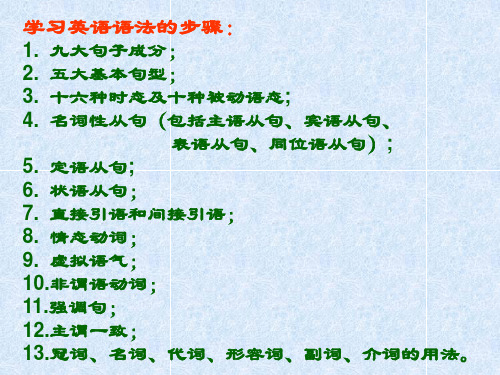
will be answered tomorrow.
9. 呼语:称呼用语。
如:Sir、Madam、Your Majesty、Your Highness
3. There be结构的句子扩充:
There be +(定语) +主语+(定语)+(地状) +(时状).
There is a book on the desk. There is an English book on the desk. There is an English book on Chinese history, which was written by a famous British historian, on the desk that stands near the window. 积木式造句法是英语学习中最简洁明了的造 句方法,同学们一定要多加练习、熟练掌握。
We will make him monitor. The good news made us happy. Please let me in. My mother gets me to read English every morning. He kept me waiting for two hours. The news that our team had won the match made
Thanks! Live with passion! Enjoy your study.
grandpa. The pen which I lost yesterday was given to me as
英语句子成分及句子结构
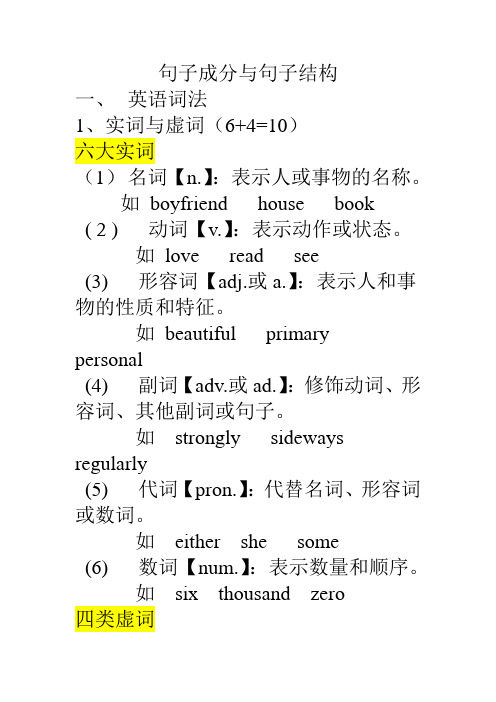
句子成分与句子结构一、英语词法1、实词与虚词(6+4=10)六大实词(1)名词【n.】:表示人或事物的名称。
如boyfriend house book( 2 ) 动词【v.】:表示动作或状态。
如love read see(3) 形容词【adj.或a.】:表示人和事物的性质和特征。
如beautiful primarypersonal(4) 副词【adv.或ad.】:修饰动词、形容词、其他副词或句子。
如strongly sideways regularly(5) 代词【pron.】:代替名词、形容词或数词。
如either she some(6) 数词【num.】:表示数量和顺序。
如six thousand zero四类虚词(7) 冠词【art.】用在名词前,表示名词的特指和泛指。
只有三个:a an the(8)介词【prep.】表示名词、代词和句中其他词的关系。
如regarding with through (9) 连词【conj.】连接词、短语、从句和句子。
如and though but(10) 感叹词【interj.】表示喜、怒、哀、乐等的情感。
如hush oh二、句子成分1、八种:主语(subject)、谓语(predicate)、宾语(object)、表语(predicative)、定语(attributive)、状语(adverbial)、补语(complement)、同位语(appositive)。
2、Say:(1)I saw your brother yesterday.(2) David is reading now.(3) You are not my cup of tea.(4) The boy playing basketball is my son.(5) All students found the exam easy.(6) She will go home to see her poor father.3、【主语】:主语说明谓语动作或状态的执行者,也就是说它表明这句话说的是谁和什么,主语主要由名词、代词、数词或相当于名词的单词,短语或从句充当。
英语语句语法结构句型

英语语句语法结构句型想要学好英语就必须了解英语句子成分和句型结构,小编在这里整理了相关知识,希望能帮助到大家。
英语句子成分句子成分(members of the sentence)英语的句子由主语部分与谓语部分组成。
具体地讲,主要有下列六种句子成分:1)主语(subject)它是句子所要说明的人或事物,是一句的主体。
如I study English(我学习英语)中的I。
2)谓语动词(predicate verb)它是说明主语的动作或状态的,如I study English中的study。
3)表语(predicative)它是放在连系动词之后表示主语的身分或特征的,如I am a student(我是一个学生)中的student;Our classroom is clean(我们的教室很干净)中的clean。
4)宾语(object)它是表示及物动词动作的对象的,如I study English中的English。
介词后面的名词或代词,叫做介词的宾语,如They don't work on Sunday(他们星期天不工作)中的Sunday,就是介词on的宾语。
5)定语(attribute)它是限定或修饰名词或代词用的,如He likes to drink co1d milk(他喜欢喝冷牛奶)中的co1d。
6)状语(adverbial)它是修饰动词、形容词、副词用的,如He works hard(他努力工作)中的hard。
[注]虚词在句子中一律不能作为句子成分。
在英文当中,有八大句子成分,分别是:主语、谓语、宾语、表语、定语、补语、同位语、状语。
主语:动词的发出对象谓语:动词宾语:动词的承受对象表语:说明主语的品质、性质、身份、特征和状态,通常在系动词(be/become/feel/sound/turn...)后面定语:用来修饰、描述主语或宾语,形容词通常做定语补语:用来补充说明主语或宾语同位语:即“同等位置”,以一个名词来解释说明另外一个名词或代词。
英语句子成分及基本句型
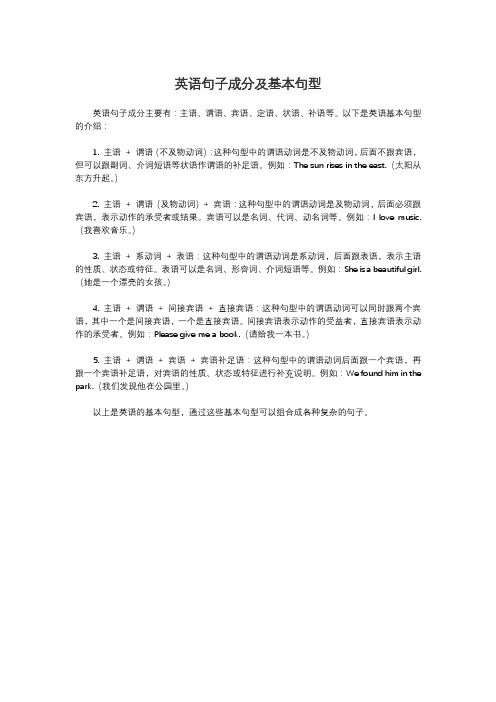
英语句子成分及基本句型
英语句子成分主要有:主语、谓语、宾语、定语、状语、补语等。
以下是英语基本句型的介绍:
1. 主语+ 谓语(不及物动词):这种句型中的谓语动词是不及物动词,后面不跟宾语,但可以跟副词、介词短语等状语作谓语的补足语。
例如:The sun rises in the east.(太阳从东方升起。
)
2. 主语+ 谓语(及物动词)+ 宾语:这种句型中的谓语动词是及物动词,后面必须跟宾语,表示动作的承受者或结果。
宾语可以是名词、代词、动名词等。
例如:I love music.(我喜欢音乐。
)
3. 主语+ 系动词+ 表语:这种句型中的谓语动词是系动词,后面跟表语,表示主语的性质、状态或特征。
表语可以是名词、形容词、介词短语等。
例如:She is a beautiful girl.(她是一个漂亮的女孩。
)
4. 主语+ 谓语+ 间接宾语+ 直接宾语:这种句型中的谓语动词可以同时跟两个宾语,其中一个是间接宾语,一个是直接宾语。
间接宾语表示动作的受益者,直接宾语表示动作的承受者。
例如:Please give me a book.(请给我一本书。
)
5. 主语+ 谓语+ 宾语+ 宾语补足语:这种句型中的谓语动词后面跟一个宾语,再跟一个宾语补足语,对宾语的性质、状态或特征进行补充说明。
例如:We found him in the park.(我们发现他在公园里。
)
以上是英语的基本句型,通过这些基本句型可以组合成各种复杂的句子。
英语学习中的基本句型结构和句子成分
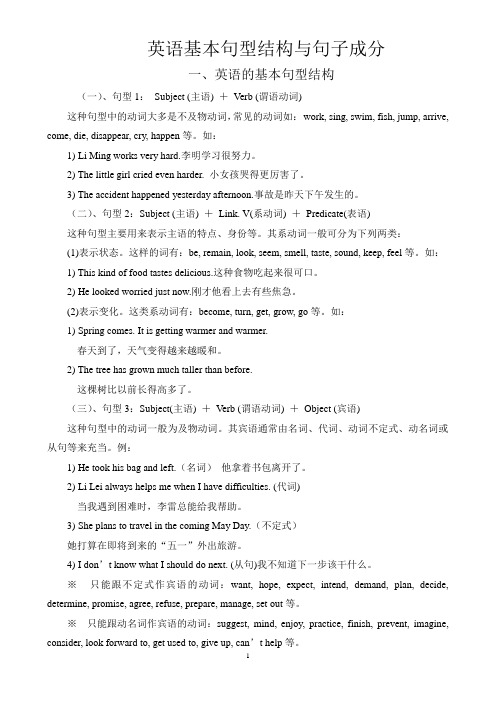
英语基本句型结构与句子成分一、英语的基本句型结构(一)、句型1:Subject (主语) +Verb (谓语动词)这种句型中的动词大多是不及物动词,常见的动词如:work, sing, swim, fish, jump, arrive, come, die, disappear, cry, happen等。
如:1) Li Ming works very hard.李明学习很努力。
2) The little girl cried even harder. 小女孩哭得更厉害了。
3) The accident happened yesterday afternoon.事故是昨天下午发生的。
(二)、句型2:Subject (主语) +Link. V(系动词) +Predicate(表语)这种句型主要用来表示主语的特点、身份等。
其系动词一般可分为下列两类:(1)表示状态。
这样的词有:be, remain, look, seem, smell, taste, sound, keep, feel等。
如:1) This kind of food tastes delicious.这种食物吃起来很可口。
2) He looked worried just now.刚才他看上去有些焦急。
(2)表示变化。
这类系动词有:become, turn, get, grow, go等。
如:1) Spring comes. It is getting warmer and warmer.春天到了,天气变得越来越暖和。
2) The tree has grown much taller than before.这棵树比以前长得高多了。
(三)、句型3:Subject(主语) +Verb (谓语动词) +Object (宾语)这种句型中的动词一般为及物动词。
其宾语通常由名词、代词、动词不定式、动名词或从句等来充当。
例:1) He took his bag and left.(名词)他拿着书包离开了。
英语句子成分及结构
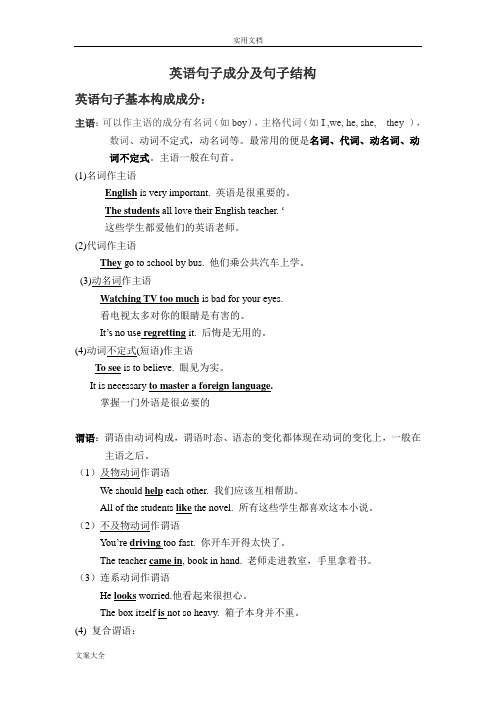
英语句子成分及句子结构英语句子基本构成成分:主语:可以作主语的成分有名词(如boy),主格代词(如I ,we, he, she, they ),数词、动词不定式,动名词等。
最常用的便是名词、代词、动名词、动词不定式。
主语一般在句首。
(1)名词作主语English is very important. 英语是很重要的。
The students all love their English teacher. ‘这些学生都爱他们的英语老师。
(2)代词作主语They go to school by bus. 他们乘公共汽车上学。
(3)动名词作主语Watching TV too much is bad for your eyes.看电视太多对你的眼睛是有害的。
It’s no use regretting it. 后悔是无用的。
(4)动词不定式(短语)作主语To see is to believe. 眼见为实。
It is necessary to master a foreign language.掌握一门外语是很必要的谓语:谓语由动词构成,谓语时态、语态的变化都体现在动词的变化上,一般在主语之后。
(1)及物动词作谓语We should help each other. 我们应该互相帮助。
All of the students like the novel. 所有这些学生都喜欢这本小说。
(2)不及物动词作谓语Yo u’re driving too fast. 你开车开得太快了。
The teacher came in, book in hand. 老师走进教室,手里拿着书。
(3)连系动词作谓语He looks worried.他看起来很担心。
The box itself is not so heavy. 箱子本身并不重。
(4) 复合谓语:①由情态动词加动词原形构成。
如:You may keep the book for two weeks.②由助动词加动词原形,现在分词,过去分词构成。
- 1、下载文档前请自行甄别文档内容的完整性,平台不提供额外的编辑、内容补充、找答案等附加服务。
- 2、"仅部分预览"的文档,不可在线预览部分如存在完整性等问题,可反馈申请退款(可完整预览的文档不适用该条件!)。
- 3、如文档侵犯您的权益,请联系客服反馈,我们会尽快为您处理(人工客服工作时间:9:00-18:30)。
一、英语句子成分和英语句子结构讲解:(一)句子成分1.主语(subject): 句子说明的人或事物。
主语可以由名词、代词、数词、不定式、动名词、分词、主语从句和短语等来担任。
The sun rises in the east.(名词)He likes dancing. (代词)Twenty years is a short time in history. (数词)Seeing is believing. (动名词)To see is to believe. (不定式)What he needs is a book. (主语从句)It is very clear that the elephant is round and tall like a tree.(It形式主语,主语从句是真正主语)找出下列句中的主语:Jane is good at playing the piano.(名词)She went out in a hurry.(代词)Four plus four is eight.(数词)To see is to believe.(不定式)Smoking is bad for health.(动名词)The young should respect the old.(名词化的形容词)What he has said is true. (句子)2.谓语(predicate): 说明主语的动作、状态和特征。
简单谓语:由动词或动词词组组成I saw the flag on the top of the hill?He looked after two orphans.复合谓语:由情态动词或助动词+动词;He can speak English well.She doesn’t seem to like dancing.找出下列句中的谓语(注:只有动词才可作谓语。
):1. We love China.2. We have finished reading this book.3. He can speak English.4. She seems tired.3.表语(predicative): 系动词之后的成分,表示主语的性质、状态和特征。
He is a teacher. (名词)Seventy-four! You don’t look it. (代词)Five and five is ten. (数词)He is asleep. (形容词)His father is in. (副词)The picture is on the wall. ( 介词短语) My watch is gone / missing / lost. (形容词化的分词)To wear a flower is to say “I’m poor, I can’t buy a ring. (不定式)The question is whether they will come. (表语从句)★(常见的系动词有: be, sound(听起来), look(看起来), feel(摸起来,smell (闻起来),taste(尝、吃起来), remain(保持,仍是), feel(感觉) ...It sounds a good idea. The sound sounds strange.Her voice sounds sweet. Tom looks thin.The food smells delicious. The food tastes good.The door remains open. Now I feel tired.找出下列句中的表语。
1. I am a teacher.2. They are on the playground.3. My job is teaching English.4. It gets cold.5. It sounds interesting.4.宾语:1)动作的承受者-----及物动词或介词的宾语I like China. (名词)He hates you. (代词)How many do you need? We need two. (数词)We should help the old and the poor. I enjoy working with you. (动名词)I hope to see you again. (不定式)Did you write down what he said? (宾语从句)2)介词后的名词、代词和动名词-----介宾Are you afraid of the snake? Under the snow, there are many rocks. 3)双宾语-----间宾(指人)和直宾(指物)宾语分为直接宾语和间接宾语.直接宾语指物或事,间接宾语指人或动物.He gave me a book yesterday. Give the poor man some money.指出下面句子的间接宾语和直接宾语:please pass me the book.He bought his girlfriend some flowers.找出下列句子的宾语部分:1. We often help him.2. He likes to play basketball.3. We enjoy listening to the music.4. She said that he felt sick.5. They are talking about the new student.5.宾补:对宾语的补充,全称为宾语补足语。
有些及物动词除了有一个直接宾语以外,还要有一个宾语补足语,说明宾语的身份和状态以补充其意义不足,使句子的意义完整。
这类常用的及物动词有:We elected him monitor. (名词)We all think it a pity that she didn’t come here. (名)We will make them happy. (形容词)We found nobody in. ( 副词) Please make yourself at home. 介词短语)Don’t let him do that. (省to不定式)His father advised him to teach the lazy boy a lesson. (带to不定式)Don’t keep the lights burning. (现在分词)I’ll have my bike repaired. (过去分词)6.主补:对主语的补充,全称为主语补足语。
He was elected monitor. She was found singing in the next room. He was advised to teach the lazy boy a lesson.7.定语:修饰或限制名词或代词的词、词组或句子。
Ai Yanling is a chemistry teacher.(名词)He is our friend. (代词)We belong to the third world. (数词)He was advised to teach the lazy boy a lesson.(形容词)The man over there is my old friend.(副词)The woman with a baby in her arms is my sister. (介词)The boys playing football are in Class 2. (现在分词)The trees planted last year are growing well now. (过去分词)I have an idea to do it well. (不定式)You should do everything that I do. (定语从句)定语后置:如果定语是由一个单词表示时,通常要前置。
而由一个词组或一个句子表示时,通常则后置The girl in red is his sister.We have a lot of work to do.The girl standing under the tree is his daughter.Do you know the man who spoke just now?8.状语:用来修饰v., adj., adv., 或句子。
表示时间、地点、原因、结果、程度、条件、方式和让步。
(以下例句按上述顺序排列)I will go there tomorrow.The meeting will be held in the meeting-room.The meat went bad because of the hot weather.He studies hard to learn English well.He didn’t study hard so that he failed in the exam. I like some of you verymuch.If you study hard, you will pass the exam. He goes to school by bike. Though he is young, he can do it well.(二)句子结构简单句的五个基本句型1.主语+不及物动词She came./ My head aches.2.主语+及物动词+宾语She likes English.3.主语+系动词+表语She is happy.4.主语+双宾动词+间接宾语+直接宾语She gave John a book.5.主语+宾补动词+宾语+宾语补语She makes her mother angry.The teacher asked me to read the passage.★There +be 句型There are some books on the desk.There lies a book on the desk.Exercises :分析下列句子成分1. Our school is not far from my home.2. It is a great pleasure to talk with you3. All of us considered him honest.4. My grandfather bought mea pair of sports shoes.5. He broke a piece of glass.6. He made it clear that he would leave the city.翻译练习:主谓结构(主语+不及物动词)1、你应该努力学习You should study hard.2、他昨天晚上很晚回家She went home very late yesterday evening.练习:1、This box weighs five kilos. 这个盒子重五公斤。
